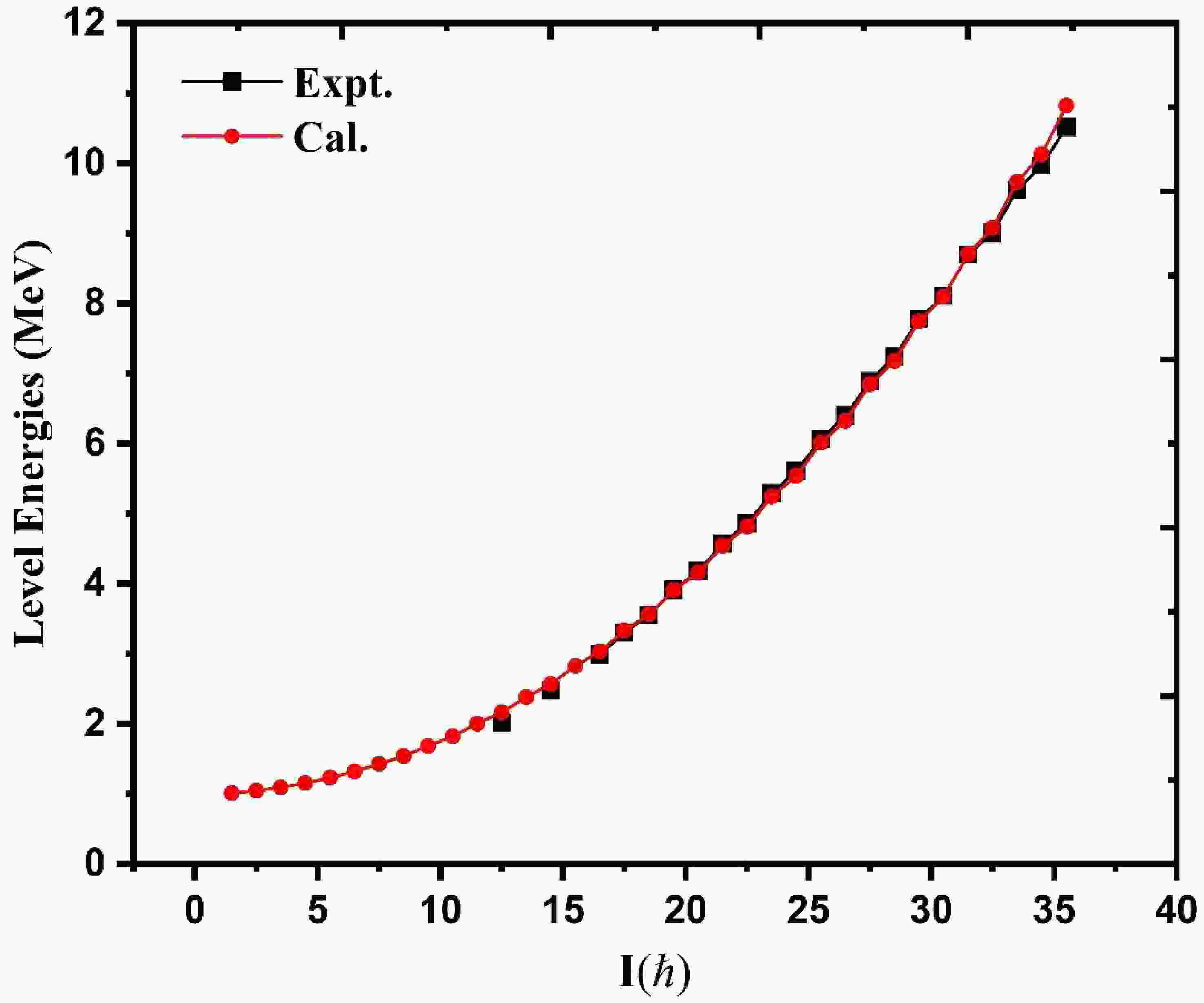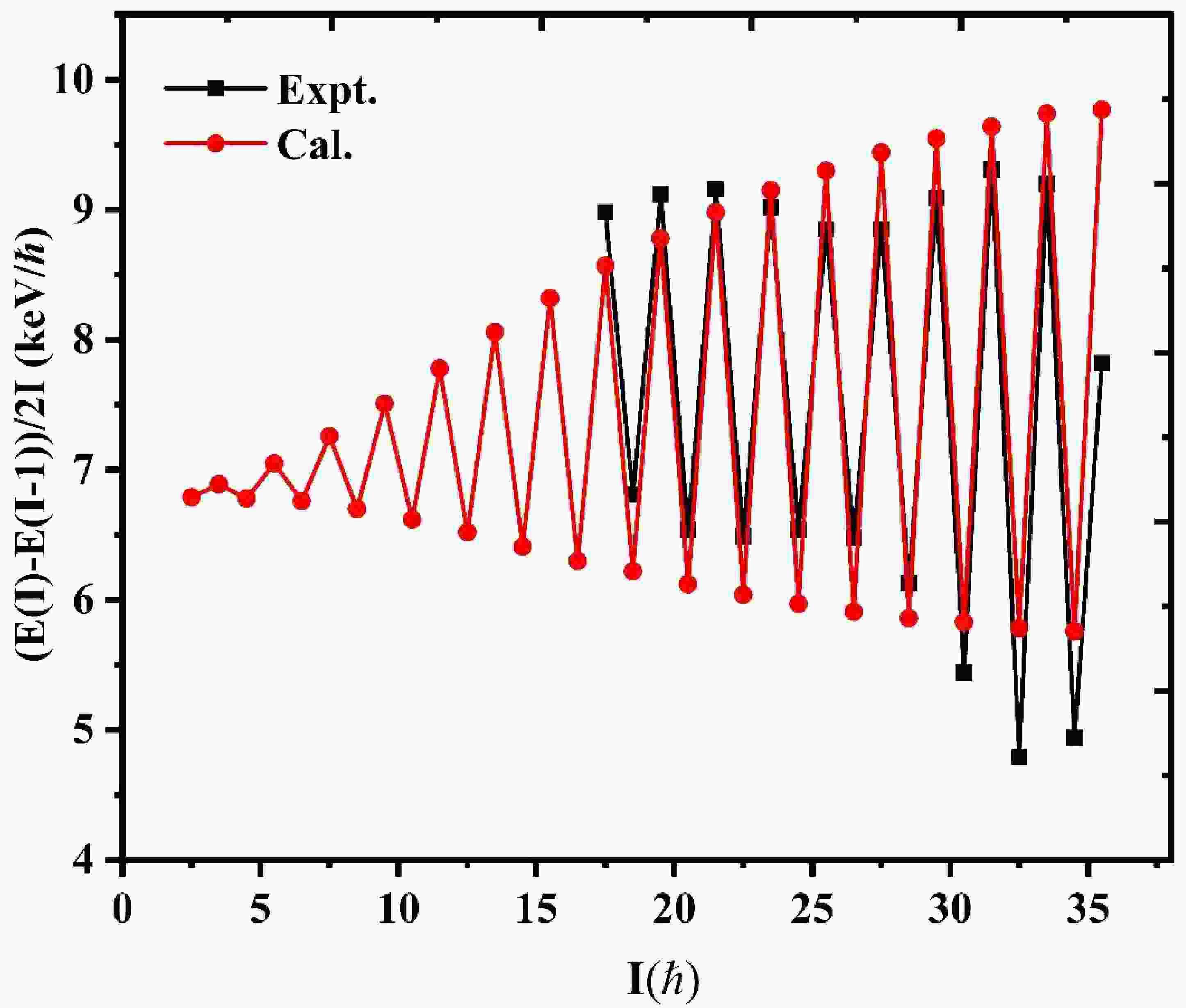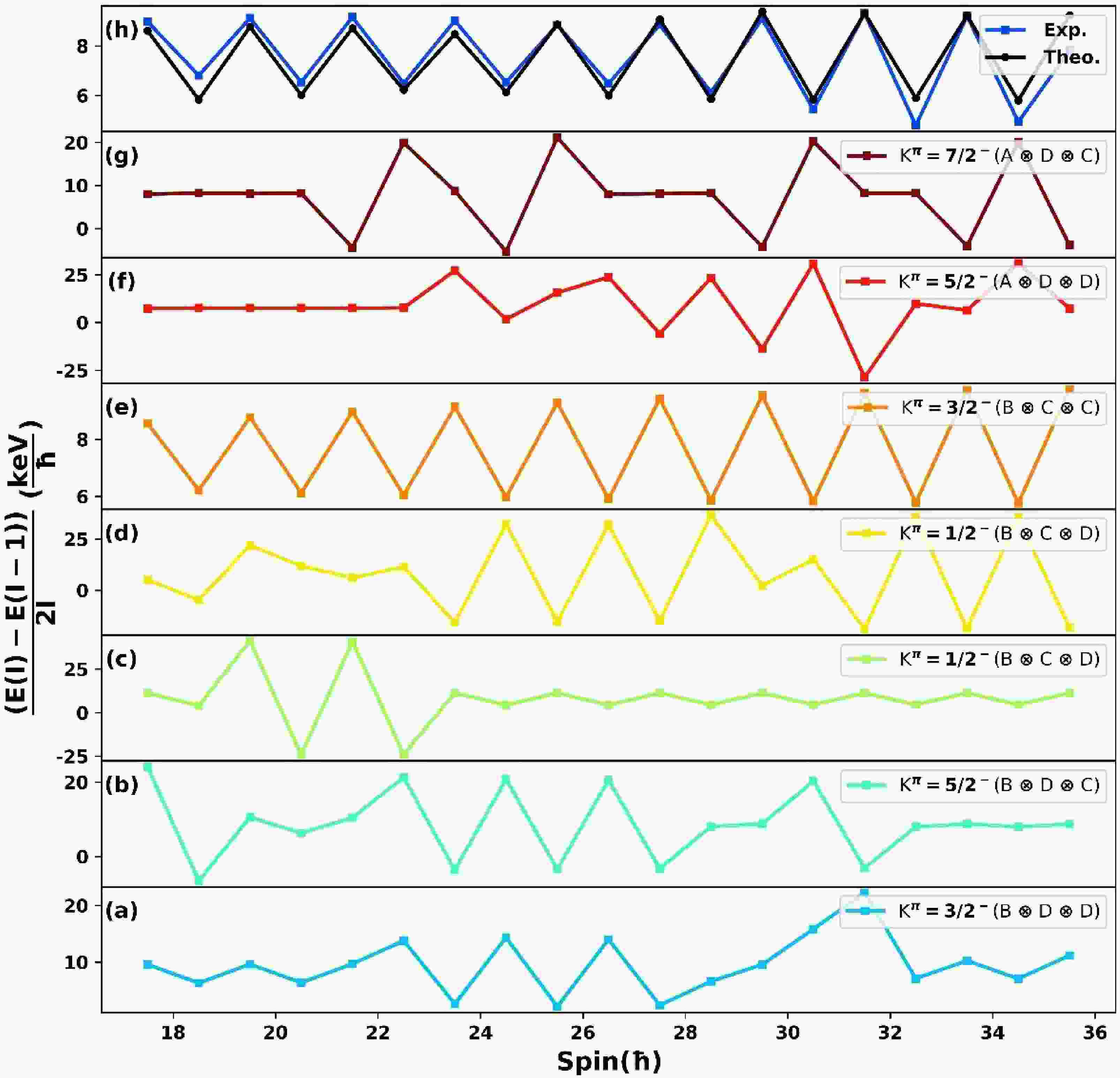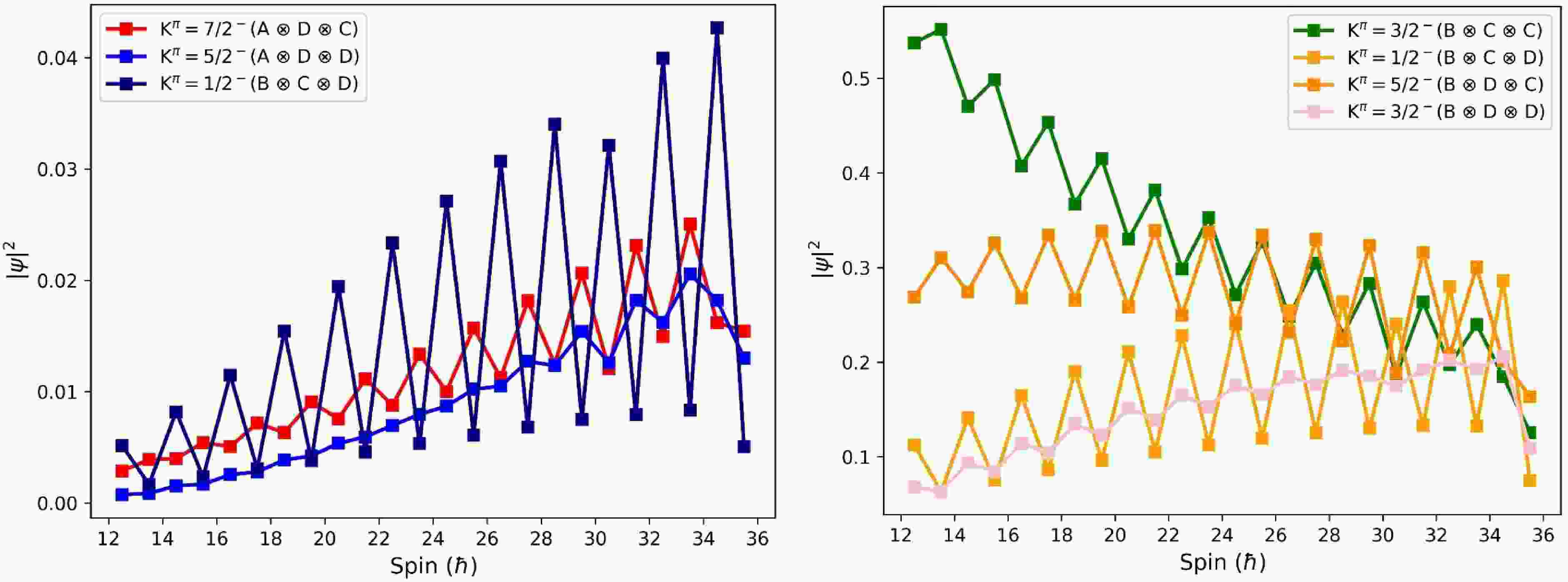-
Due to the invariance of nuclear wave function under rotation by an angle π about an axis perpendicular to the symmetry axis, the two ΔI=2 rotational branches of a given band are observed instead of one ΔI=1 rotational branch. This splitting of
$ \alpha = + {1 \mathord{\left/ {\vphantom {1 2}} \right. } 2} $ signature branch with respect to the$ \alpha = - {1 \mathord{\left/ {\vphantom {1 2}} \right. } 2} $ branch of the same band is known as signature splitting and observed in the rotational bands composed of neutrons and/or protons occupying high-j orbitals. Since last three decades, considerable efforts have been made to explain the physical mechanisms facilitating the observed signature splitting and the signature inversion in one-quasiparticle (1qp) and two-quasiparticle (2qp) rotational bands observed in odd-A [1-3], odd-odd [4-9], and even-even [10,11] nuclei. These investigations revealed various possible causes such as γ-deformation/triaxiality, residual n-p interactions, contribution of rotor-particle and particle-particle couplings for the observed odd-even staggering in 1qp and 2qp rotational bands. A very limited efforts have been made to investigate the signature effects of three-quasiparticle (3qp) rotational bands observed in odd-A nuclei. Matsuzaki et al. [12,13] proposed a microscopic model which includes both the static and dynamical triaxial deformation into the total Hamiltonian and studied these effects in 3qp rotational bands observed in 157Ho, 159Tm, 161,165Lu nuclides. They suggested that increase in signature splitting is a consequence of increase in deformation parameter with neutron number. It was emphasis that more accurate and systematic data of signature splitting and B(M1) and B(E2) ratios are required to perform more realistic calculations. Ikeda et al. [14] adopted a particle plus symmetric rotor model with γ-vibrational degree of freedom and suggested that γ-dependency of the moment of inertia can influence the signature splitting and signature inversion decisively. They attempted to explain signature inversion observed in 157Ho, 163Lu, and 165Lu nuclides but the same calculations become less consistent in the case of 159Tm, 161Lu, and 155Ho nuclides [14].In present paper, we performed axially symmetric Three-Quasiparticle Plus Rotor Model (3QPPRM) [15,16] calculations for theoretical explanation of signature splitting observed in a three-quasineutron rotational band based on 3/2[521]ν
$\otimes $ 1/2[660]ν$\otimes $ 1/2[660]ν configuration of 155Dy (Band No. 5 &7 of [17]). The particle rotor model calculations have advantage over other calculations as this approach is in terms of an angular momentum- a physical observable in the experiments and hence a direct comparison with the experimental data can be made. We successfully reproduced the experimental level energies, phase and magnitude of experimentally observed staggering pattern, and also proposed the bandhead assignment as Kπ=3/2- for the band under discussion. The underlying reasons for the observed signature splitting are understood in terms of rotor-particle and particle-particle couplings among various rotational bands participating in the given basis space. The present article is organized as follows: section 2 briefly describes the methodology of 3QPPRM, section 3 presents detailed discussion of the results and the main conclusions made from the present study are summarized in section 4. -
In present calculations, we used an axially symmetric Three Quasiparticle Plus Rotor Model (3QPPRM) which incorporates first and higher order Coriolis mixing of various 3qp rotational bands comprising the basis space designed for the band under discussion. In this approach, the total Hamiltonian (H) is divided into following two parts [15,16]:
$ H = {H_{{int} }}_{rinsic} + {H_{collective}} $

(1) where the first term,
$ {H_{{int} rinsic}} $ consists of a Hamiltonian pertaining to a deformed axially symmetric mean field potential ($ {H_{av}} $ ),$ {H_{pair}} $ - pairing Hamiltonian,$ {H_{res}} $ - residual neutron-proton interactions The collective part (${H_{collective}}$ ) can be further divided into the$ H_{rot}^o $ - a purely rotational contribution,$ {H_{irrot}} $ - irrotational component,$ {H_{ppc}} $ - contribution corresponding to the couplings of particles among themselves,$ {H_{rpc}} $ - contribution from the coupling of particles with even-even core, and$ {H_{vib}} $ - which corresponds to vibrational interactions. Due to the weak coupling among the rotational and vibrational degree of freedom, the vibrational interaction is not considered in the present model formulation. Therefore, the total Hamiltonian can be written as:$ H = {H_{av}} + {H_{pair}} + H_{rot}^o + {H_{irrot}} + {H_{ppc}} + {H_{rpc}} + {H_{res}} $

(2) $ {H_{av}} $ is the Nilsson model Hamiltonian with modified harmonic oscillator potential [18], the eigen values and the single particle wavefunctions are calculated using potential parameters ($ {k_p},\,\,{\mu _p} $ for protons and$ {k_n},\,\,{\mu _n} $ for neutrons) adopted from Jain et al. [19] and deformation parameters ($ {\varepsilon _2},\,\,{\varepsilon _4} $ ) adopted from Moller et al. [20]. The contribution of pairing Hamiltonian (${H_{pair}}$ ) is estimated using finite difference mass formulae [21] by using binding energies from latest mass evaluation [22]. The analytical form of the various terms that contribute to the total Hamiltonian are:$ H_{rot}^o = \frac{{{\hbar ^2}}}{{2\Im }}\left[ {{I^2} - I_z^2} \right] $

(3) $ {H_{irrot}} = \frac{{{\hbar ^2}}}{{2\Im }}\left[ {(j_1^2 - j_{1z}^2) + (j_2^2 - j_{2z}^2) + (j_3^2 - j_{3z}^2)} \right] $

(4) $\begin{aligned}[b] {H_{ppc}} =\;& \frac{{{\hbar ^2}}}{{2\Im }}\big[ ({j_{{1^ + }}}{j_{{2^ - }}} + {j_{{1^ - }}}{j_{{2^ + }}}) + ({j_{{2^ + }}}{j_{{3^ - }}} + {j_{{2^ - }}}{j_{{3^ + }}})\\& + ({j_{{1^ + }}}{j_{{3^ - }}} + {j_{{1^ - }}}{j_{{3^ + }}}) \big] \end{aligned}$

(5) $ {H_{rpc}} = - \frac{{{\hbar ^2}}}{{2\Im }}\left[ {{I_ + }{J_ - } + {I_ - }{J_ + }} \right] $

(6) where,
$\Im $ is the moment of inertia with respect to the rotation axis, subscripts (1, 2, and 3) represent particle 1, particle 2, and particle 3 constituting a given 3qp state,$I = R + J$ is the total angular momentum,$R$ is the angular momentum of an even-even core and$J = {j_1} + {j_2} + {j_3}$ is the total intrinsic angular momentum. The${I_ \pm } = {I_x} \pm i{I_y},\,$ $\,{I_ \pm } = {I_{{1^ \pm }}} + {I_{{2^ \pm }}} + {I_{{3^ \pm }}},$ $ {J_ \pm } = {J_x} \pm i{J_y},\, $ $ {J_ \pm } = {j_{{1^ \pm }}} + {j_{{2^ \pm }}} + {j_{{3^ \pm }}} $ are raising and lowering operators. The matrix elements corresponding to above mentioned Hamiltonians in the$ \left| {IMK\alpha } \right\rangle $ basis is given as [15,16]:$ \begin{aligned}[b]\left\langle {IMK'\alpha '} \right|H_{rot}^o\left| {IMK\alpha } \right\rangle =\;& \,\left\langle {IMK'\alpha '} \right|\frac{{{\hbar ^2}}}{{2\Im }}\left[ {{I^2} - I_z^2} \right]\left| {IMK\alpha } \right\rangle \\=\;& \frac{{{\hbar ^2}}}{{2\Im }}\left[ {I(I + 1) - {K^2}} \right]{\delta _{K'K}}{\delta _{\alpha '\alpha }}\\[-15pt] \end{aligned}$

(7) $\begin{aligned}[b]& \left\langle {IMK'\alpha '} \right|{H_{irrot}}\left| {IMK\alpha } \right\rangle \\=\;& \,\frac{{{\hbar ^2}}}{{2\Im }}\left[ \begin{gathered} \left( {\sum\limits_{{j_1}} {{{\left| {C_{{k_1}}^{{j_1}}} \right|}^2}{j_1}({j_1} + 1) - k_1^2} } \right) + \\ \left( {\sum\limits_{{j_2}} {{{\left| {C_{{k_2}}^{{j_2}}} \right|}^2}{j_2}({j_2} + 1) - k_2^2} } \right) + \\ \left( {\sum\limits_{{j_3}} {{{\left| {C_{{k_3}}^{{j_3}}} \right|}^2}{j_3}({j_3} + 1) - k_3^2} } \right) \\ \end{gathered} \right]{\delta _{K'K}}{\delta _{\alpha '\alpha }}\end{aligned} $

(8) $ \left\langle {IMK'\alpha '} \right|{H_{ppc}}\left| {IMK\alpha } \right\rangle = \,\frac{{{\hbar ^2}}}{{2\Im }}\left[ \begin{gathered} \left( {\left\langle {{{k'}_1}{{\rho '}_1}} \right|{j_{{1^ + }}}\left| {{k_1}{\rho _1}} \right\rangle \left\langle {{{k'}_2}{{\rho '}_2}} \right|{j_{{2^ - }}}\left| {{k_2}{\rho _2}} \right\rangle + \left\langle {{{k'}_1}{{\rho '}_1}} \right|{j_{{1^ - }}}\left| {{k_1}{\rho _1}} \right\rangle \left\langle {{{k'}_2}{{\rho '}_2}} \right|{j_{{2^ + }}}\left| {{k_2}{\rho _2}} \right\rangle } \right){\delta _{{{k'}_3}{k_3}}}{\delta _{{{\rho '}_3}{\rho _3}}} \\ + \left( {\left\langle {{{k'}_2}{{\rho '}_2}} \right|{j_{{2^ + }}}\left| {{k_2}} \right\rangle \left\langle {{{k'}_3}{{\rho '}_3}} \right|{j_{{3^ - }}}\left| {{k_3}{\rho _3}} \right\rangle + \left\langle {{{k'}_2}{{\rho '}_2}} \right|{j_{{2^ - }}}\left| {{k_2}{\rho _2}} \right\rangle \left\langle {{{k'}_3}{{\rho '}_3}} \right|{j_{{3^ + }}}\left| {{k_3}{\rho _3}} \right\rangle } \right){\delta _{{{k'}_1}{k_1}}}{\delta _{{{\rho '}_1}{\rho _1}}} \\ + \left( {\left\langle {{{k'}_1}{{\rho '}_1}} \right|{j_{{1^ + }}}\left| {{k_1}{\rho _1}} \right\rangle \left\langle {{{k'}_3}{{\rho '}_3}} \right|{j_{{3^ - }}}\left| {{k_3}{\rho _3}} \right\rangle + \left\langle {{{k'}_1}{{\rho '}_1}} \right|{j_{{1^ - }}}\left| {{k_1}{\rho _1}} \right\rangle \left\langle {{{k'}_3}{{\rho '}_3}} \right|{j_{{3^ + }}}\left| {{k_3}{\rho _3}} \right\rangle } \right){\delta _{{{k'}_2}{k_2}}}{\delta _{{{\rho '}_2}{\rho _2}}} \\ \end{gathered} \right]{\delta _{K'K}} $

(9) $ \left\langle {IMK'\alpha '} \right|{H_{rpc}}\left| {IMK\alpha } \right\rangle = - \frac{{{\hbar ^2}}}{{2\Im }}\left[ \begin{gathered} \left( {\sqrt {(I + K)(I - K + 1)} \,\left\langle {{{k'}_1}{{\rho '}_1}{{k'}_2}{{\rho '}_2}{{k'}_3}{{\rho '}_3}} \right|{j_{{1^ - }}} + {j_{{2^ - }}} + {j_{{3^ - }}}\left| {{k_1}{\rho _1}{k_2}{\rho _2}{k_3}{\rho _3}} \right\rangle \,} \right){\delta _{K',K - 1}} \\ + \,\left( {\sqrt {(I - K)(I + K + 1)} \,\left\langle {{{k'}_1}{{\rho '}_1}{{k'}_2}{{\rho '}_2}{{k'}_3}{{\rho '}_3}} \right|{j_{{1^ + }}} + {j_{{2^ + }}} + {j_{{3^ + }}}\left| {{k_1}{\rho _1}{k_2}{\rho _2}{k_3}{\rho _3}} \right\rangle \,} \right){\delta _{K',K + 1}} \\ + {\left( { - 1} \right)^{I + K}}\left( {\sqrt {(I + K)(I - K + 1)} \,\left\langle {{{k'}_1}{{\rho '}_1}{{k'}_2}{{\rho '}_2}{{k'}_3}{{\rho '}_3}} \right|\left( {{j_{{1^ + }}} + {j_{{2^ + }}} + {j_{{3^ + }}}} \right){R_x}\left| {{k_1}{\rho _1}{k_2}{\rho _2}{k_3}{\rho _3}} \right\rangle \,} \right){\delta _{K', - K + 1}} \\ \end{gathered} \right] $

(10) $ {H_{res}} $ is the Hamiltonian corresponding to residual n-p interactions [15] and breaks degeneracy among various members of a given 3qp quadruplet and can be estimated using empirical data of Gallagher-Moszkowski (GM) splitting [23,24] and Newby shift energies [25]. The wave functions corresponding to the total Hamiltonian can be written as the product of Wigner D-functions ($D_{MK}^I$ ) and the intrinsic wave functions$\left| {K\alpha } \right\rangle $ [15,16]:$ \left| {IMK\alpha } \right\rangle = \sqrt {\frac{{2I + 1}}{{16{\pi ^2}}}} \left[ {\left| {D_{MK}^I} \right\rangle \left| {K\alpha } \right\rangle + {{( - 1)}^{I + K}}\left| {D_{M - K}^I} \right\rangle {R_x}(\pi )\left| {K\alpha } \right\rangle } \right] $

(11) where, the index
$\alpha $ characterizes the configuration$(\alpha = {\rho _1}{\rho _2}{\rho _3})$ of the unpaired particles such that$ {H_{av}}\left| {K\alpha } \right\rangle = \left( {{\varepsilon _1}{\rho _1} + {\varepsilon _2}{\rho _2} + {\varepsilon _3}{\rho _3}} \right)\left| {K\alpha } \right\rangle $ ,${\varepsilon _1}{\rho _1}$ ,${\varepsilon _2}{\rho _2}$ and${\varepsilon _3}{\rho _3}$ are the quasiparticle energies of the quasiparticle states${\rho _1}$ ,${\rho _2}$ and${\rho _3}$ respectively.For a given 3qp quadruplet, various types of couplings of intrinsic angular momenta gives four bandheads namely,
$ {K}_{1}=\left|{k}_{1}+{k}_{2}+{k}_{3}\right|,{K}_{2}=\left|{k}_{1}+{k}_{2}-{k}_{3}\right|,{K}_{3}= |{k}_{1}-{k}_{2}+ {k}_{3}| $ and$ {K}_{4}=\left|-{k}_{1}+{k}_{2}+{k}_{3}\right| $ and hence basis space comprising the 3qp quadruplets involved in Coriolis mixing calculations becomes large and complex as compared to the basis space involved in one and two quasiparticle Coriolis mixing calculations. Additionally, the limited availability of the required input data (GM splitting & Newby Shift energies) for the calculations of bandhead energies of the bands taking part in the given basis space, restricts the more appropriate choice of the basis space. Therefore, a special care is exercised to design the basis space including all the possible bands interacting through rotor-particle (ΔK=1) and particle-particle couplings (ΔK=0) and then resultant matrix is diagonalized to obtain energy eigen values and eigen vectors. -
In present work, we examined the signature splitting observed in 3qp rotational band based on 3/2[521]ν
$\otimes $ 1/2[660]ν$\otimes $ 1/2[660]ν configuration of 155Dy (Band No. 5 & 7 of [17]) using 3QPPRM. This band is observed in the spin range Iπ=25/2- to 93/2- with a band crossing at Iπ=73/2- where it changes its character from three-quasiparticle to five-quasiparticle (5qp) rotational structure [17]. Additionally, the low-lying members (below Iπ=25/2-) of the band under discussion could not identified in the available experimental investigations, and hence predictions of these members in the present calculations will guide the future experimental investigations of these lower spin levels of the band under discussion. In order to explain the phase as well as magnitude of experimentally observed signature splitting, the basis space consisting of 48 three-quasiparticle rotational bands stemming from the combination of 5/2[512], 3/2[521], 1/2[530], 1/2[660] and 3/2[651] quasineutrons is constituted. Each 3qp rotational band participating in the given basis space is characterized by three parameters namely, the bandhead energy ($ {E_\alpha } $ ), inertia parameter ($ {{{\hbar ^2}} \mathord{\left/ {\vphantom {{{\hbar ^2}} {2\Im }}} \right. } {2\Im }} $ ) and Newby shift energy(${E_N}$ ). To estimate the bandhead energies of all the bands comprising the given basis space of the present calculations, we used an improved version of semi-empirical formulation [26,27]. The input values of inertia parameters ($ {{{\hbar ^2}} \mathord{\left/ {\vphantom {{{\hbar ^2}} {2\Im }}} \right. } {2\Im }} $ ) are estimated using experimental data of first two levels of a given 3qp rotational band, if available, otherwise it is calculated by using inertia parameters of valence nucleons of neighboring odd-A and even-even nuclei as${\Im _{3qp}} = {\Im _{(1)}} + {\Im _{(2)}} + {\Im _{(3)}} - {\Im _{even - even}}$ , where${\Im _{(1)}}$ ,${\Im _{(2)}}$ ,${\Im _{(3)}}$ are odd nucleon moments of inertia and${\Im _{even - even}}$ is the moment of inertia of the even-even core. The matrix elements and single particle wavefunctions taking part in present 3QPPRM calculations are obtained using the Nilsson model [18] with deformation parameters as$ {\varepsilon _2} $ =0.210,$ {\varepsilon _4} $ =-0.02 [20] and potential parameters as$ {\kappa _n} $ =0.0636,$ {\mu _n} $ =0.393 [19].In Figure 1, we presented the variation of signature splitting (E(I)-E(I-1)/2I) with spin (
$\hbar $ ) for the rotational band built over 3/2[521]ν$\otimes $ 1/2[660]ν$\otimes$ 1/2[660]ν configuration observed in 155Dy (Band No. 5 & 7 of [17]). The magnitude of signature splitting within spin range Iπ=25/2-$\hbar $ to 71/2-$\hbar $ varies from 4.79 keV to 9.31 keV.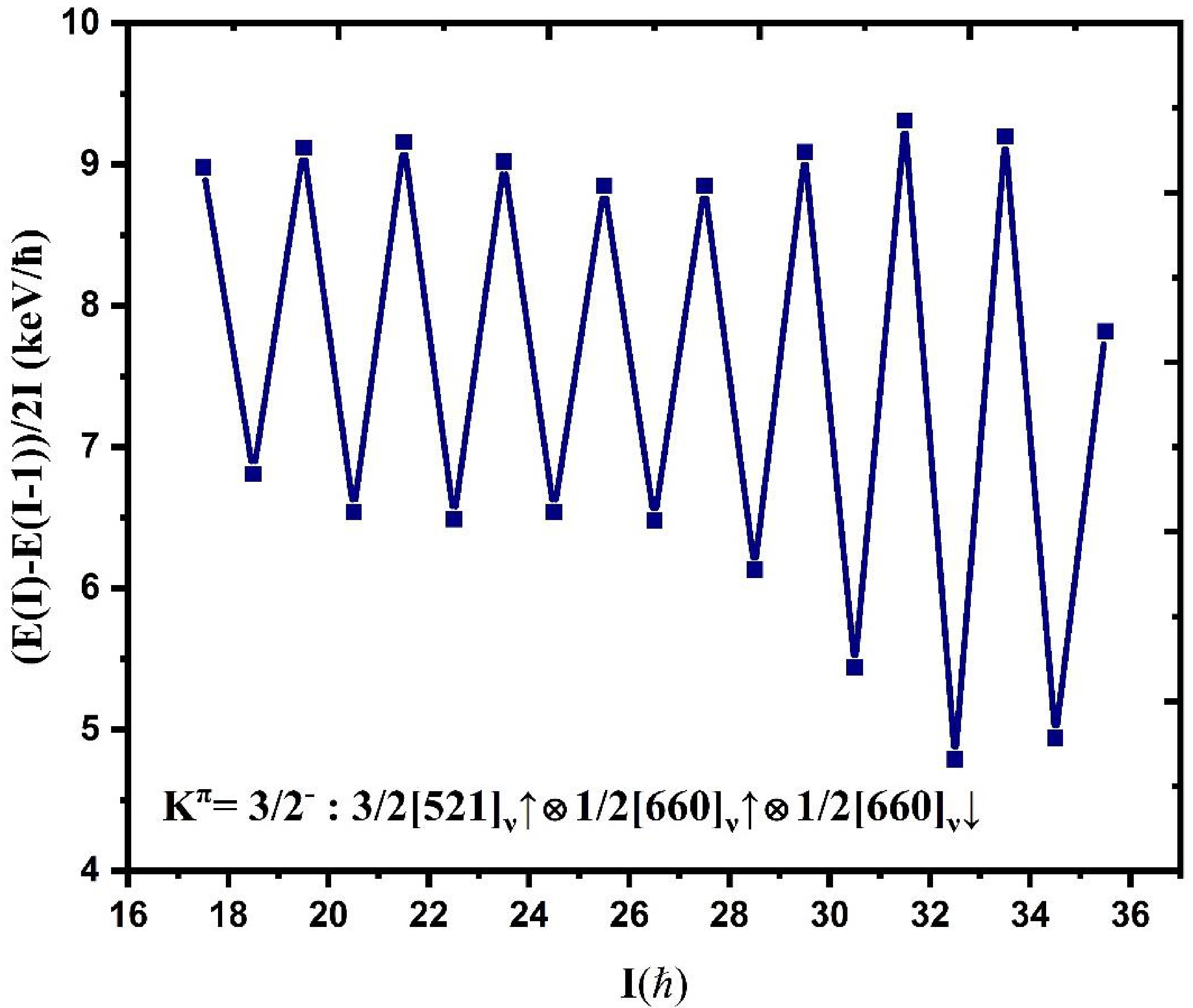
Figure 1. (color online) Experimentally observed signature splitting in three-quasineutron rotational band 3/2[521]ν
$\otimes $ 1/2[660]ν$\otimes $ 1/2[660]ν of 155Dy (Band No. 5 & 7 of [17]).To explain the observed signature splitting, we designed a structured basis space comprising 48 three-quasiparticle rotational bands taking part in present Coriolis mixing calculations. The values of the input parameters (
$ {E_\alpha } $ ,$ {{{\hbar ^2}} \mathord{\left/ {\vphantom {{{\hbar ^2}} {2\Im }}} \right. } {2\Im }} $ and${E_N}$ ) are varied within physical limits by minimizing χ2 deviation [29] among calculated level energies and experimental data. The optimized set of values of the input parameters pertaining to the strongly interacting rotational bands are listed in Table 1. In Figure 2, we present comparison of experimental and calculated energies and from this figure, it is clear that level energies of the three-quasineutron band under discussion are well reproduced with a reasonable RMS deviation of 68.13 keV. These level energies along with calculated and experimental values of Eγ (M1) and Eγ (E2) are listed in Table 2.S.No Configuration Ω[NnzΛ]∑ Kπ Eα (keV) Inertia (ħ2/keV−1) GM Splitting /(Newby shift) (keV) (1,2) (2,3) (3,1) 1. 5/2[512]ν↑ $\otimes $ 3/2[651]ν↑

$\otimes $ 1/2[660]ν↓

7/2- 2202.1 8.27 368 400 368 2. 5/2[512]ν↑ $\otimes $ 3/2[651]ν↑

$\otimes $ 3/2[651]ν↓

5/2- 2080.1 8.27 368 400 (−70) 368 3. 3/2[521]ν↑ $\otimes $ 1/2[660]ν↑

$\otimes $ 1/2[660]ν↓

3/2- 1000.0 8.61 368 400 (66.15) 368 4. 3/2[521]ν↑ $\otimes $ 1/2[660]ν↑

$\otimes $ 3/2[651]ν↓

1/2- 1505.0 8.27 368 400 368 (200) 5. 3/2[521]ν↓ $\otimes $ 1/2[660]ν↑

$\otimes $ 3/2[651]ν↑

1/2- 1537.0 8.27 368 400 368 (200) 6. 3/2[521]ν↑ $\otimes $ 3/2[651]ν↑

$\otimes $ 1/2[660]ν↓

5/2- 1305.0 8.27 368 (200) 400 368 7. 3/2[521]ν↑ $\otimes $ 3/2[651]ν↑

$\otimes $ 3/2[651]ν↓

3/2- 1382.9 8.27 368 (200) 400 (−70) 368 (200) Matrix elements among quasineutron states $ \left\langle {{1 \mathord{\left/ {\vphantom {1 2}} \right. } 2}\left[ {530} \right]} \right|{J_ + }\left| {{1 \mathord{\left/ {\vphantom {1 2}} \right. } 2}\left[ {530} \right]} \right\rangle $ 

−0.971 (2.854) $ \left\langle {{1 \mathord{\left/ {\vphantom {1 2}} \right. } 2}\left[ {660} \right]} \right|{J_ + }\left| {{1 \mathord{\left/ {\vphantom {1 2}} \right. } 2}\left[ {660} \right]} \right\rangle $ 

0.069 (1.082) $ \left\langle {{3 \mathord{\left/ {\vphantom {3 2}} \right. } 2}\left[ {651} \right]} \right|{J_ + }\left| {{1 \mathord{\left/ {\vphantom {1 2}} \right. } 2}\left[ {660} \right]} \right\rangle $ 

0.923 (2.558) $ \left\langle {{1 \mathord{\left/ {\vphantom {1 2}} \right. } 2}\left[ {660} \right]} \right|{J_ + }\left| {{1 \mathord{\left/ {\vphantom {1 2}} \right. } 2}\left[ {660} \right]} \right\rangle $ 

0.069 (0.174) $ \left\langle {{3 \mathord{\left/ {\vphantom {3 2}} \right. } 2}\left[ {651} \right]} \right|{J_ + }\left| {{1 \mathord{\left/ {\vphantom {1 2}} \right. } 2}\left[ {660} \right]} \right\rangle $ 

0.923 (1.546) Table 1. Optimized set of parameters (bandhead energies (Eα), Inertia parameter (ħ2/keV-1), Newby shift & matrix elements) of the strongly interacting rotational bands of the given basis space of present 3QPPRM calculations. The GM splitting and Newby shift energies used in the present calculations are adopted from Kondev [28] and Singh et al. [16] respectively. The Newby shift energies contributing to K=0 bands, are given in parenthesis along with the GM splitting energies. The optimized values of matrix elements are given in parenthesis and listed in the lower part of this table.
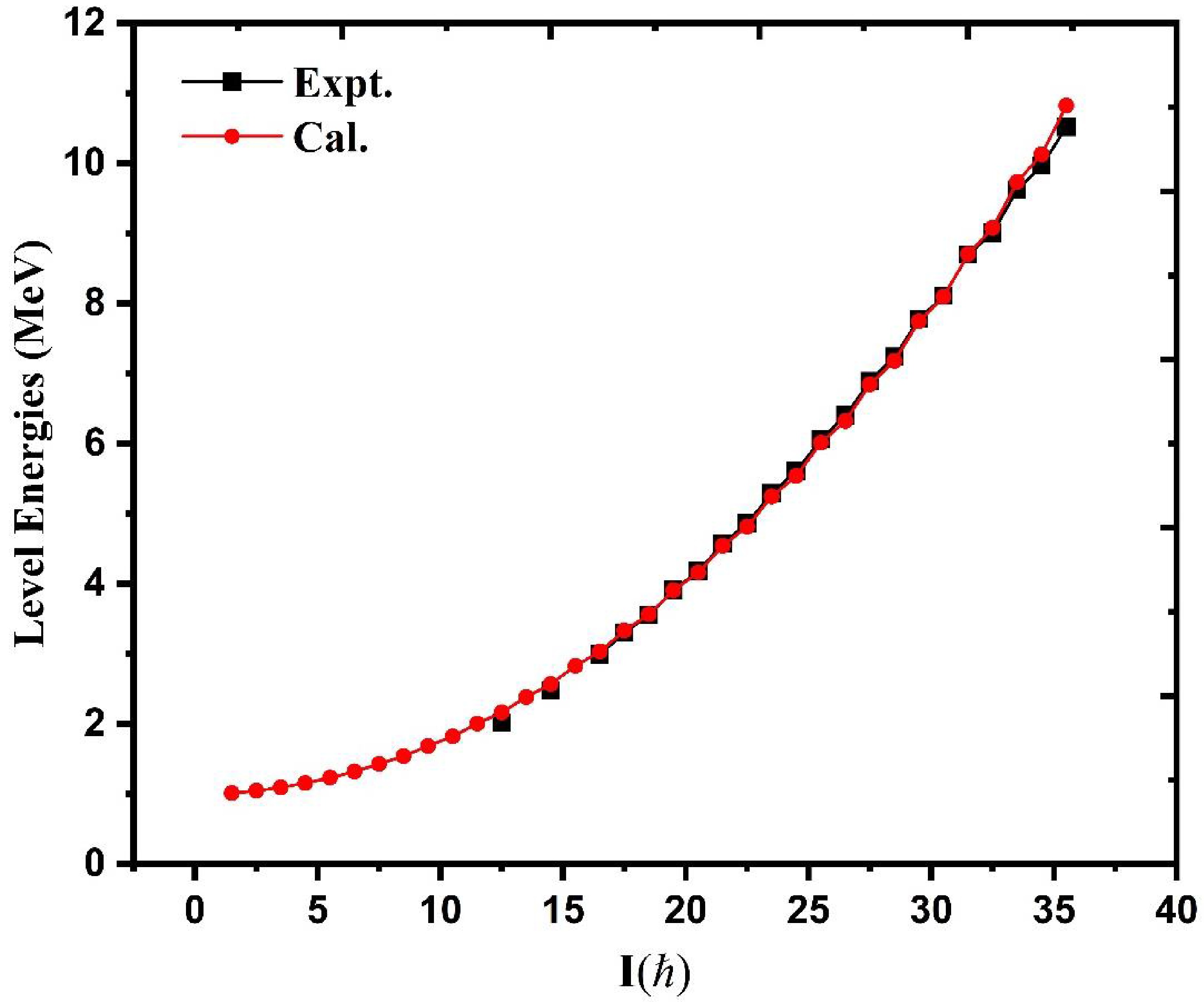
Figure 2. (color online) Comparison of calculated level energies with the experimental data of three-quasineutron Kπ = 3/2-: 3/2[521]ν↑
$\otimes $ 1/2[660]ν↑$\otimes $ 1/2[660]ν↓ band observed in 155Dy (Band No. 5 &7 of [17]).$ {E}_{level}^{expt.} $ 

(keV)Initial State Final State $ {E}_{\gamma }^{expt.} $ 

(keV)$ {E}_{level}^{theo.} $ 

(keV)$ {E}_{\gamma }^{theo.} $ 

(keV)$ {I}_{i}^{\pi } $ 

$ {I}_{f}^{\pi } $ 

2012.3 25/2- − − 2165.8 − − 27/2- − − 2383.3 − 2475.6 29/2- 25/2- 463.3 2569.3 403.5 − 31/2- − − 2827.2 − 2990.2 33/2- 29/2- 514.6 3035.2 465.9 3304.4 35/2- − − 3335.1 − 3556.3 37/2- 33/2- 566.1 3565.0 529.8 3912.1 39/2- 35/2- 607.7 3907.4 572.3 4180.2 41/2- 37/2- 623.9 4158.5 593.5 4573.9 43/2- 39/2- 661.8 4544.4 637.0 4865.8 45/2- 41/2- 685.6 4816.4 657.9 5289.7 47/2- 43/2- 715.8 5246.5 702.1 5610.2 49/2- 45/2- 744.4 5539.2 722.8 6061.8 51/2- 47/2- 772.1 6013.6 767.1 6405.2 53/2- 49/2- 795.0 6327.0 787.8 6892.2 55/2- 51/2- 830.4 6846.1 832.5 7241.4 57/2- 53/2- 836.2 7180.1 853.1 7778.0 59/2- 55/2- 885.8 7743.8 897.7 8109.7 61/2- 57/2- 868.3 8099.5 919.4 8696.4 63/2- 59/2- 918.4 8707.0 963.2 9008.0 65/2- 61/2- 898.3 9082.9 983.4 9624.4 67/2- 63/2- 928.0 9735.3 1028.3 9965.3 69/2- 65/2- 957.3 10132.6 1049.7 10520.6 71/2- 67/2- 896.2 10826.5 1091.2 Table 2. Comparison of experimental and calculated level energies and transition energies.
In Figure 3, we presented the comparison of calculated and experimentally observed odd-even staggering pattern with spin. From this figure, it is clear that the present model calculations successfully reproduced the phase as well as magnitude of observed signature splitting with RMS deviation of 0.58 keV. On the basis of the good agreement among calculated level energies with experimental data, we suggest bandhead spin as Kπ=3/2- to the rotational band under investigation. We also confirm the three-quasineutron configuration assignment as 3/2[521]ν↑
$\otimes $ 1/2[660]ν↑$\otimes $ 1/2[660]ν↓, which could not get confirmed from the available experimental data. Additionally, the prediction of lower-lying members will be useful for experimentalists in future investigations. Since, the band under discussion is the only experimentally observed band among the 48 three-quasineutron rotational bands comprising the given basis space and hence comparison of calculated level energies of remaining 47 rotational bands of given basis space with experimental data is not possible. In order to further strengthen the validity of our 3QPPRM calculations, we therefore, extracted the calculated staggering patterns of the bands interacting strongly through ΔK=0 (particle-particle) and ΔK=1 (rotor-particle) couplings and are presented in Figure 4.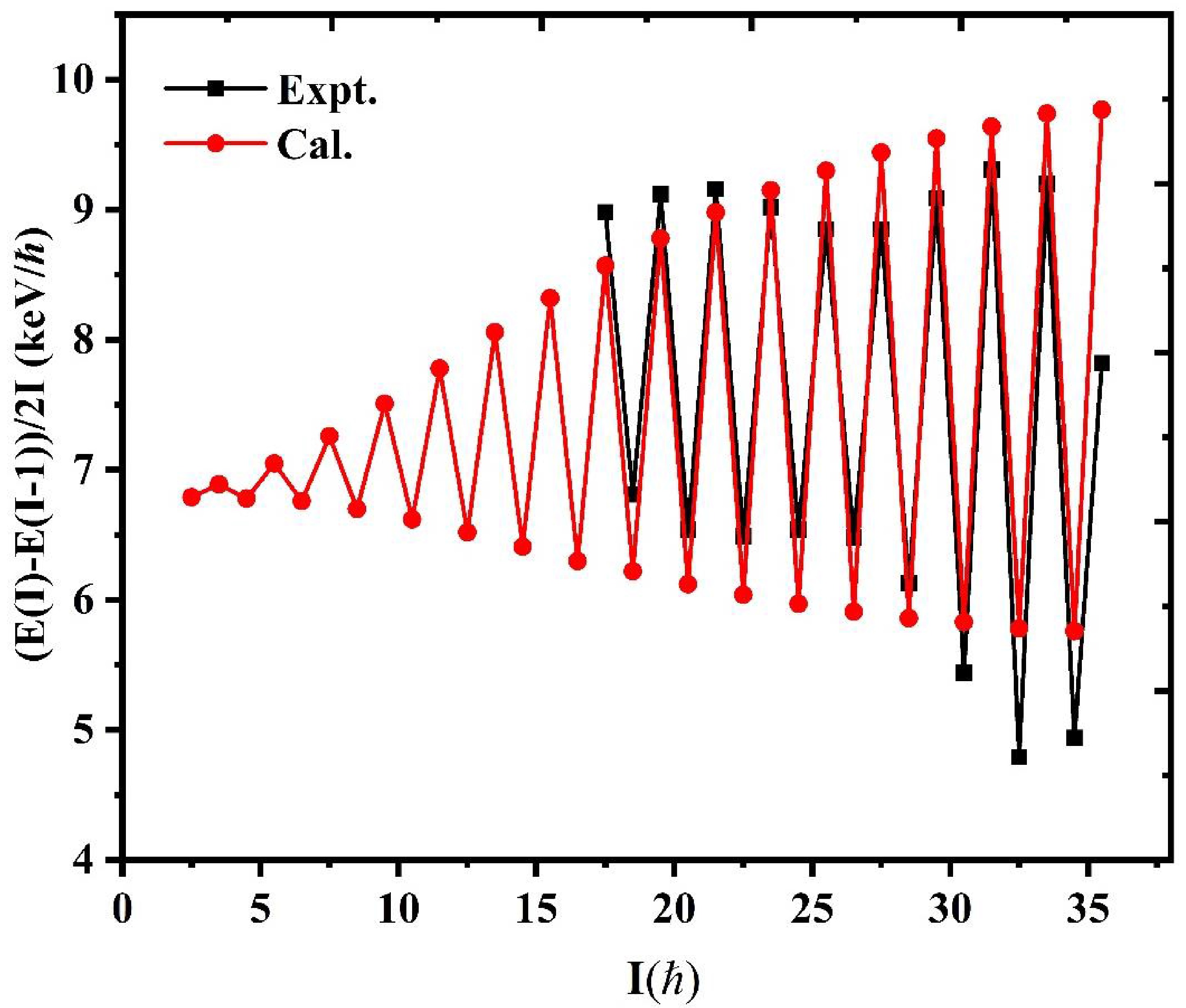
Figure 3. (color online) Comparison of calculated and experimental staggering pattern exhibited by three-quasineutron rotational band based on Kπ= 3/2- :3/2[521]ν↑
$\otimes $ 1/2[660]ν↑$\otimes $ 1/2[660]ν↓ configuration of 155Dy.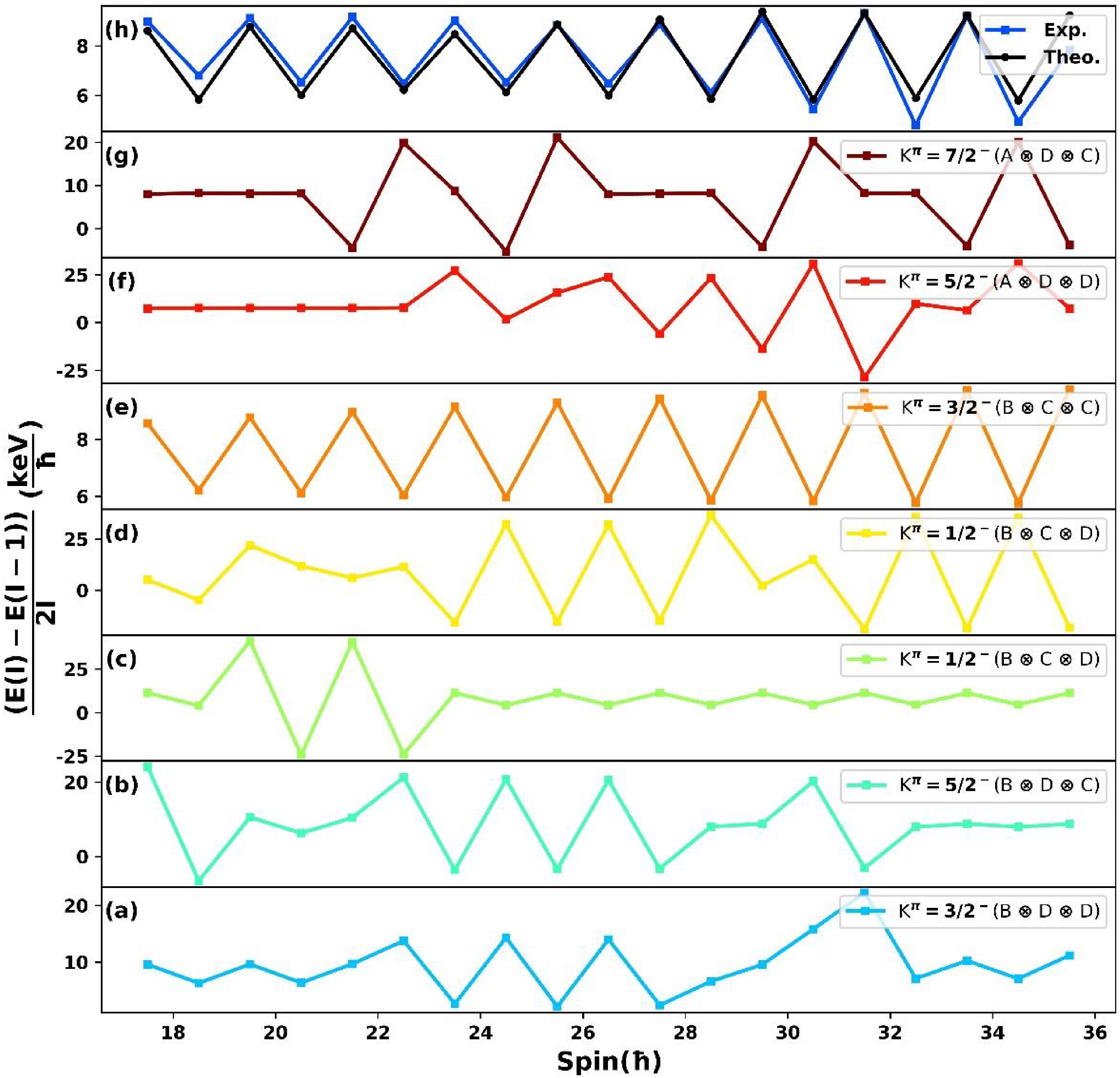
Figure 4. (color online) Signature splitting of strongly interacting rotational bands obtained in present 3QPPRM rotor model calculations. In top panel, the results of the superimposed staggered pattern are compared with the experimental data, where A: 5/2[512], B: 3/2[521], C: 1/2[660] and D: 3/2[651] represents quasineutron states.
In the top panel of this figure, we presented the superposition of energy staggering calculated for Kπ=7/2: 5/2[512]ν↑
$\otimes $ 3/2[651]ν↑$\otimes $ 1/2[660]ν↓, Kπ=5/2-: 5/2[512]ν↑$\otimes $ 3/2[651]ν↑$\otimes $ 3/2[651]ν↓, Kπ=3/2- :3/2[521]ν↑$\otimes $ 1/2[660]ν↑$\otimes $ 1/2[660]ν↓, Kπ=1/2-:3/2[521]ν↑$\otimes $ 1/2[660]ν↑$\otimes $ 3/2[651]ν↓, Kπ=1/2-: 3/2[521]ν↓$\otimes $ 1/2[660]ν↑$\otimes $ 3/2[651]ν↑, Kπ=5/2-: 3/2[521]ν↑$\otimes $ 3/2[651]ν↑$\otimes $ 1/2[660]ν↓ and Kπ=3/2-: 3/2[521]ν↑$\otimes $ 3/2[651]ν↑$\otimes $ 3/2[651]ν↓ bands and also compared the superimposed staggering pattern with the experimental data of the band under discussion. The excellent matching of superimposed staggering pattern with the experimental data (as given in top panel of Fig. 4) gives us a good confidence in our calculated energies of various bands taking part in the present Coriolis mixing calculations. The staggering amplitude parameters obtained in the above said superposition are 0.011, -0.0093, 0.963, 0.0073, 0.0010, 0.0146 and -0.0065, respectively for the above-mentioned bands. The observed irregularities in the staggering patterns of the dominant bands can be attributed to differences in how strongly each band couples with the constituent bands that form the basis space.On the basis of present calculations, we assign bandhead spin as Kπ= 3/2- to a three-quasineutron 3/2[521]ν↑
$\otimes$ 1/2[660]ν↑$\otimes $ 1/2[660]ν↓ rotational band under discussion. Additionally, we also predicted the location of 13 lower-lying members (Iπ=3/2- to 23/2-, 27/2- and 31/2-) of this band, which will be useful for future experimental investigations. In Figure 5(a,b), we also presented the variation of amplitude of the mixed wave functions ($ {\left| \psi \right|^2} $ ) with spin of the bands interacting strongly through Coriolis and particle-particle couplings.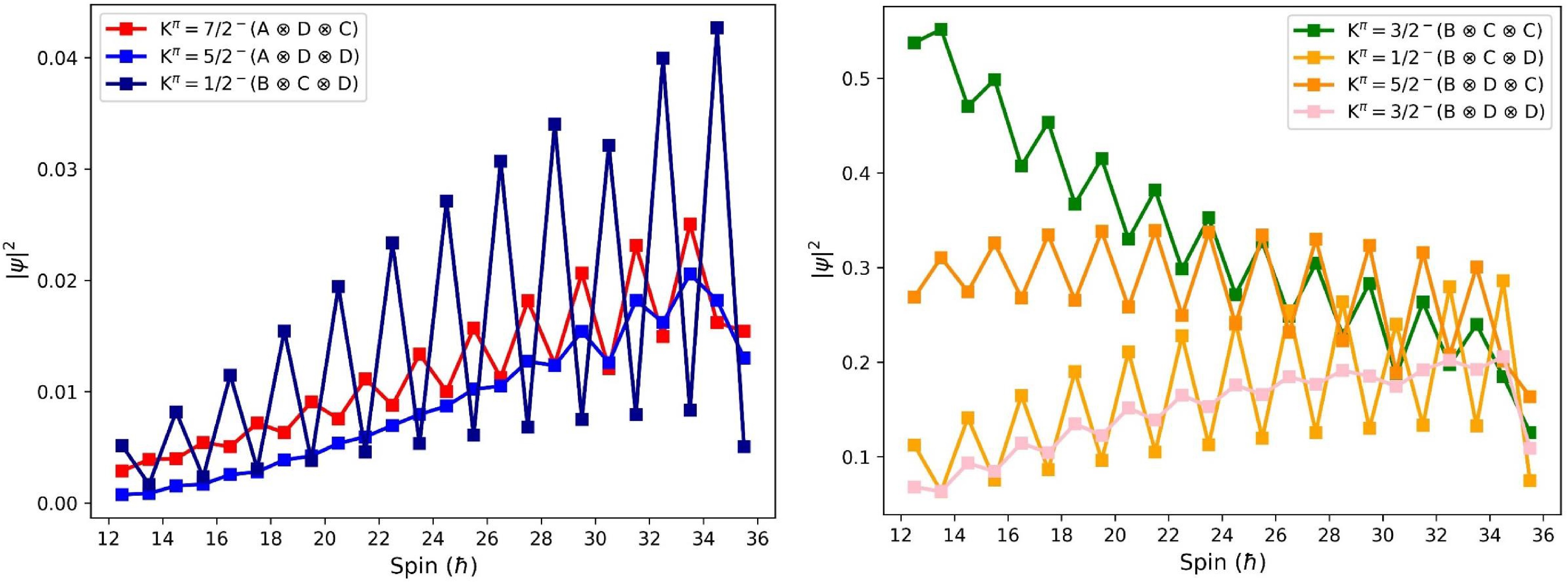
Figure 5. (color online) (a): Variation of amplitude (
$ {\left| \psi \right|^2} $ ) of mixed wave functions with spin of the strongly interacting rotational bands participating in the basis space. (b): Same as figure 5(a) but for another set of rotational bands contributing substantially in the band under discussion, where B: 3/2[521], C: 1/2[660] and D: 3/2[651] represents quasineutron states. -
Three quasiparticle plus rotor model calculations are performed for the theoretical explanation of observed signature splitting in three-quasineutron 3/2[521]ν
$\otimes $ 1/2[660]ν$\otimes $ 1/2[660]ν rotational band of 155Dy. The experimentally deduced level energies as well as the magnitude of observed signature splitting in the spin range of Iπ=25/2-$\hbar $ to 71/2-$\hbar $ is successfully reproduced with a reasonable RMS deviation of 68.13 keV and 0.58 keV, respectively. The bands contributing substantially in the above said staggering are Kπ=7/2-: 5/2[512]ν↑$\otimes $ 3/2[651]ν↑$\otimes $ 1/2[660]ν↓, Kπ=5/2-: 5/2[512]ν↑$\otimes $ 3/2[651]ν↑$\otimes $ 3/2[651]ν↓, Kπ=1/2-: 3/2[521]ν↑$\otimes $ 1/2[660]ν↑$\otimes $ 3/2[651]ν↓, Kπ=1/2-: 3/2[521]ν↓$\otimes $ 1/2[660]ν↑$\otimes $ 3/2[651]ν↑, Kπ=5/2-: 3/2[521]ν↑$\otimes $ 3/2[651]ν↑$\otimes $ 1/2[660]ν↓ and Kπ=3/2-: 3/2[521]ν↑$\otimes $ 3/2[651]ν↑$\otimes $ 3/2[651]ν↓, which interact strongly through Coriolis (ΔK=0) and particle-particle couplings (ΔK=1). The amplitude ($ {\left| \psi \right|^2} $ ) of the mixed wavefunctions of the strongly interacting bands also exhibit staggering pattern, which is an unusual feature. The observed signature splitting is also well reproduced by the superposition of energy staggering calculated for the strongly interacting bands, which further strengthen the validity of our calculations. Based on the present calculations, we assign the bandhead spin as Kπ=3/2-: 3/2[521]ν↑$\otimes $ 1/2[660]ν↑$\otimes $ 1/2[660]ν↓ to the band under discussion. We also predicted the locations of 13 lower-lying members corresponding to spin Iπ=3/2- to 23/2-, 27/2- and 31/2- of the band under discussion, which will be useful for future experimental investigations.
Signature Splitting in Three-quasineutron Rotational Band 3/2[521]ν$\otimes $ 1/2[660]ν$\otimes $ 1/2[660]ν of 155Dy
- Received Date: 2025-03-27
- Available Online: 2025-11-01
Abstract: The signature splitting observed in 3/2[521]ν↑






 Abstract
Abstract HTML
HTML Reference
Reference Related
Related PDF
PDF

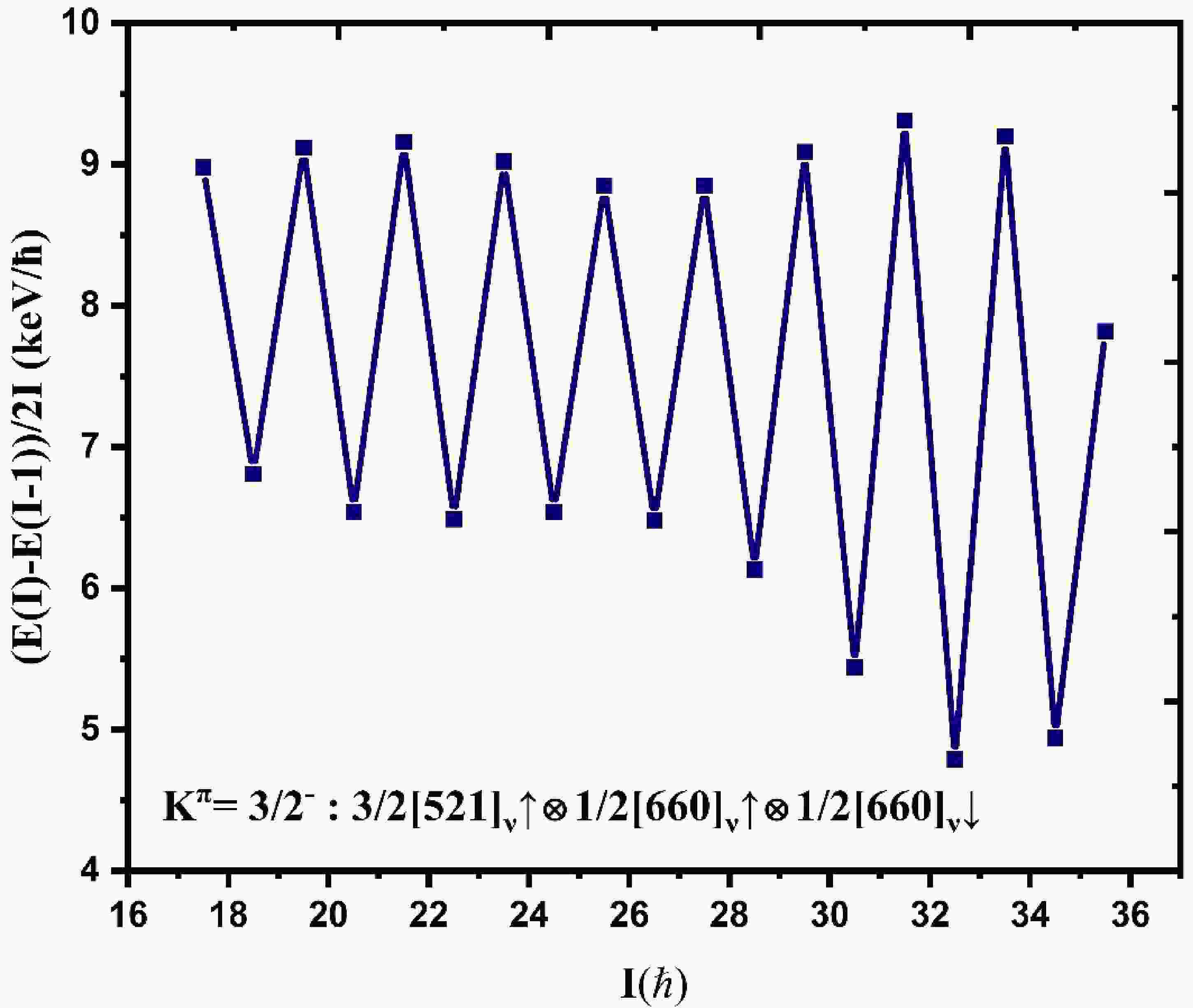













 DownLoad:
DownLoad:
